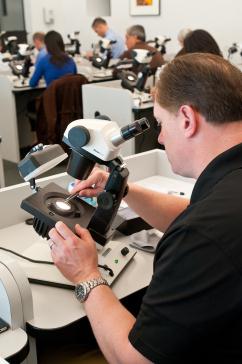GIA Helps Fight Crime, Holds Course for Special Agents
April 12, 12
(IDEX Online News) – Helping in the fight against gem- and jewelry-related crime, the GIA (Gemological Institute of America) recently held an intensive two-week course for 22 special agents and detectives from international agencies.
 FBI Special Agent Daniel McCaffrey Participates in a Custom-Designed Laboratory Class at the GIA World Headquarters in Carlsbad, California Image © GIA |
According to the FBI’s Uniform Crime Report, more than $1.5 billion of jewelry and precious metals were stolen in the U.S. in 2010, with a recovery rate of only around 4.2 percent, according to the Uniform Crime Report issued by the FBI.
The goals of the seminar were to teach practical gemology for use in investigations and demonstrate how GIA resources are available to assist in criminal cases. As well as training in the 4C’s, the law enforcement personnel from Canada, Hong Kong, Malaysia and South Africa, along with representatives from 13 U.S. cities, learnt to read a GI grading report, how jewelry is made and how stolen jewelry is broken down, among other skills.
“Our mission is to protect the public in gemstone and jewelry purchases,” said Donna Baker, president and CEO of GIA. “We’re pleased to have built a strong working relationship with law enforcement agencies around the world. By working together, we can help reduce gem-related crimes.”
“Jewelry theft is often a gateway crime,” said FBI Supervisory Special Agent Eric Ives, organized crime and major theft program manager. “These crimes are often associated with very sophisticated and sometimes violent international criminal enterprises involved in other criminal violations, including money laundering. The illicit proceeds from the trafficking of stolen jewelry are sometimes used to fund other criminal activities.”
Special Agent Daniel McCaffrey described one case in which identifying the stone in an engagement ring led to identification of a murder victim. Investigators were able to trace the ring back to the jeweler who sold the ring by flagging it in the database, which eventually led them to the victim’s family.
In the 1980s, a database of diamonds and colored stones with GIA grading reports was started to assist law enforcement in identifying gemstones involved in crimes. Stones, even if they have been re-cut, can be identified in the system. Another way GIA can identify a stone is through a laser inscription. A police report with a certified English translation is required to utilize this system.